
Quarterly Australian Milk Production Update – Oct ’19
Executive Summary
Australian milk production figures provided by Dairy Australia were recently updated with values spanning through the first quarter of the ’19-’20 production season. Highlights from the updated report include:
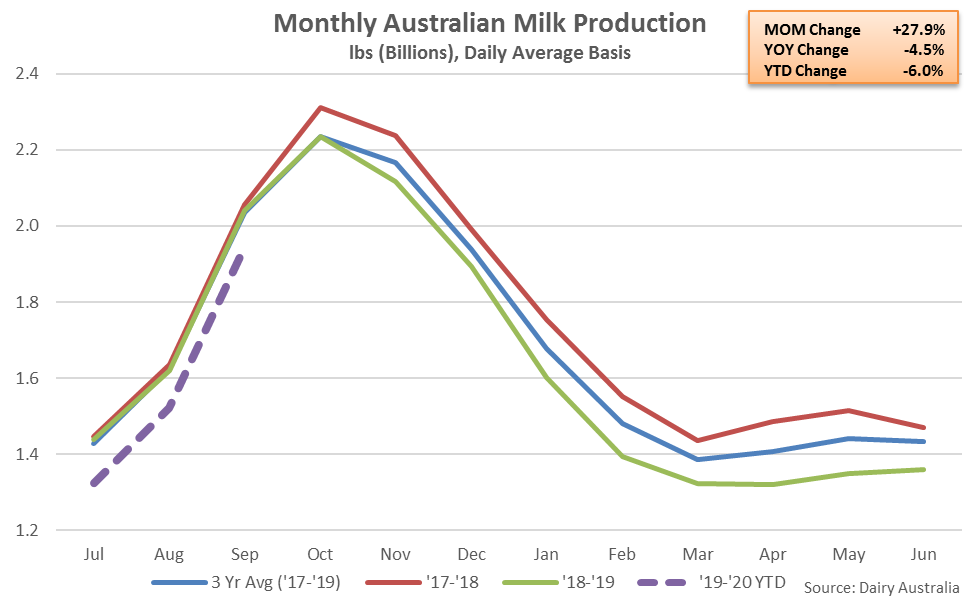 ’17-’18 annual Australian milk production increased 3.0% from the 20 year low experienced throughout the previous production season as improved rainfall led to better pasture growth however ’18-’19 annual production declined 5.7% as dry weather conditions returned, reaching a 24 year low level, overall. USDA has projected a 7.5% YOY decline in Australian milk production throughout the 2019 calendar year due to the likely continuation of unfavorable seasonal conditions in most dairy regions. Australian milk production volumes have declined 8.1% YOY throughout the first three quarters of the 2019 calendar year.
’17-’18 annual Australian milk production increased 3.0% from the 20 year low experienced throughout the previous production season as improved rainfall led to better pasture growth however ’18-’19 annual production declined 5.7% as dry weather conditions returned, reaching a 24 year low level, overall. USDA has projected a 7.5% YOY decline in Australian milk production throughout the 2019 calendar year due to the likely continuation of unfavorable seasonal conditions in most dairy regions. Australian milk production volumes have declined 8.1% YOY throughout the first three quarters of the 2019 calendar year.
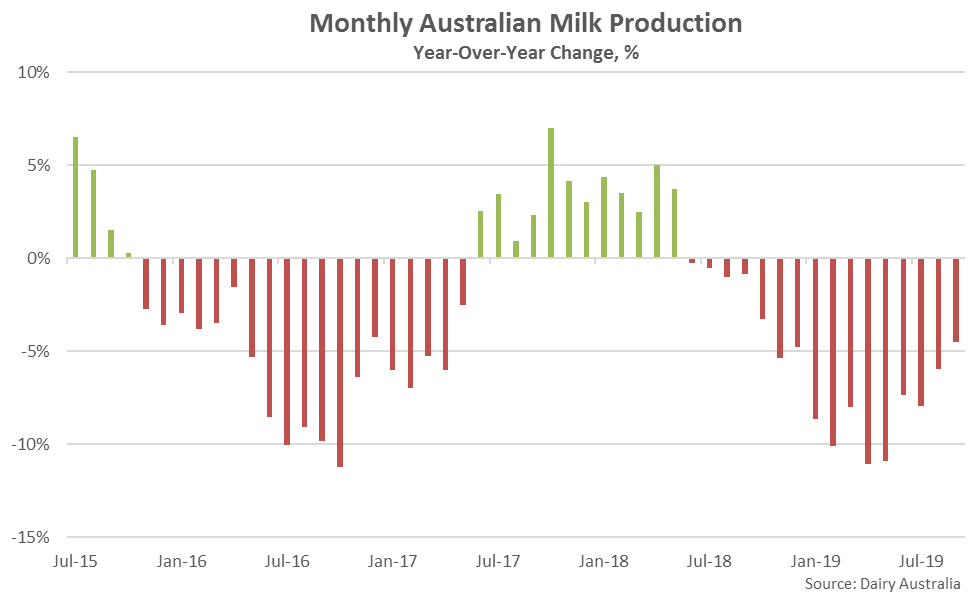 Recently experienced adverse conditions contributed to the Australian dairy cow herd contracting by 3.2% throughout 2017, to 1.51 million head, finishing at the lowest figure on record. The Australian dairy cow herd rebounded slightly throughout 2018 as rising farmgate milk prices supported herd rebuilding, however USDA expects the Australian dairy cow herd to decline 50,000 head, or 3.3%, throughout 2019, finishing at the lowest figure on record. Low pasture volumes and supplementary feed on hand are expected to contribute to the decline in cow numbers throughout the second half of 2019.
Recently experienced adverse conditions contributed to the Australian dairy cow herd contracting by 3.2% throughout 2017, to 1.51 million head, finishing at the lowest figure on record. The Australian dairy cow herd rebounded slightly throughout 2018 as rising farmgate milk prices supported herd rebuilding, however USDA expects the Australian dairy cow herd to decline 50,000 head, or 3.3%, throughout 2019, finishing at the lowest figure on record. Low pasture volumes and supplementary feed on hand are expected to contribute to the decline in cow numbers throughout the second half of 2019.
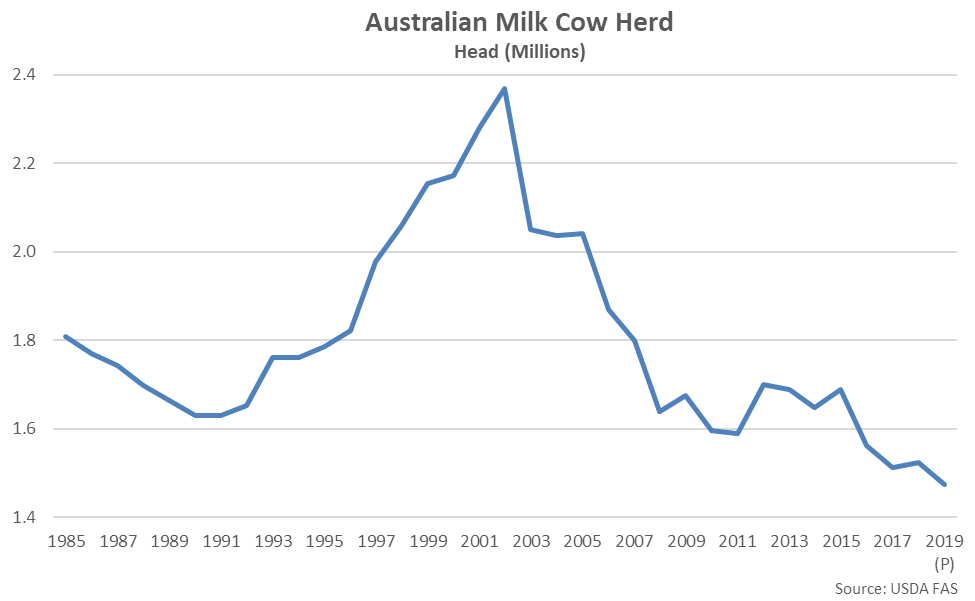 Australia is the fourth largest global dairy exporter, trailing only New Zealand, the EU-28 and the U.S. Of the top five dairy exporting regions accounting for over 90% of total global dairy exports, Australia accounts for 3.1% of total combined milk production and 6.5% of combined butter, cheese, nonfat dry milk (NFDM) and whole milk powder (WMP) export volumes throughout 2018.
Australia is the fourth largest global dairy exporter, trailing only New Zealand, the EU-28 and the U.S. Of the top five dairy exporting regions accounting for over 90% of total global dairy exports, Australia accounts for 3.1% of total combined milk production and 6.5% of combined butter, cheese, nonfat dry milk (NFDM) and whole milk powder (WMP) export volumes throughout 2018.
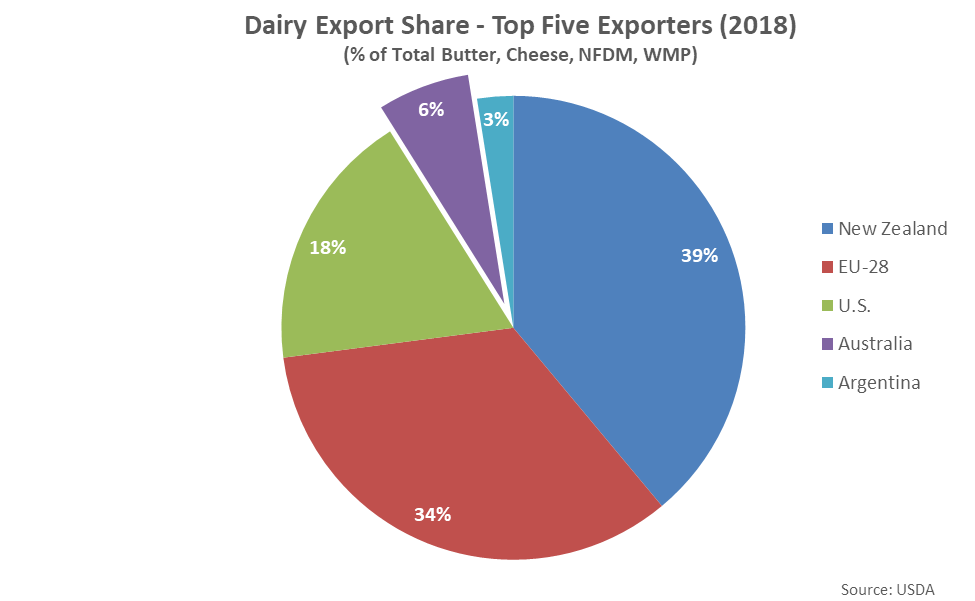 The bulk of Australian dairy exports are in the form of cheese and NFDM. Australia was the fourth largest exporter of both cheese and NFDM throughout 2018, accounting for 8.9% of global cheese export volumes and 6.6% of global NFDM export volumes. A growing population, coupled with strong demand for milk and dairy products, is expected to result in lower Australian dairy exports over the next year if milk production volumes remain lower YOY. From a global perspective, cheese and NFDM markets may be most affected by a continued decline in Australian milk production.
The bulk of Australian dairy exports are in the form of cheese and NFDM. Australia was the fourth largest exporter of both cheese and NFDM throughout 2018, accounting for 8.9% of global cheese export volumes and 6.6% of global NFDM export volumes. A growing population, coupled with strong demand for milk and dairy products, is expected to result in lower Australian dairy exports over the next year if milk production volumes remain lower YOY. From a global perspective, cheese and NFDM markets may be most affected by a continued decline in Australian milk production.
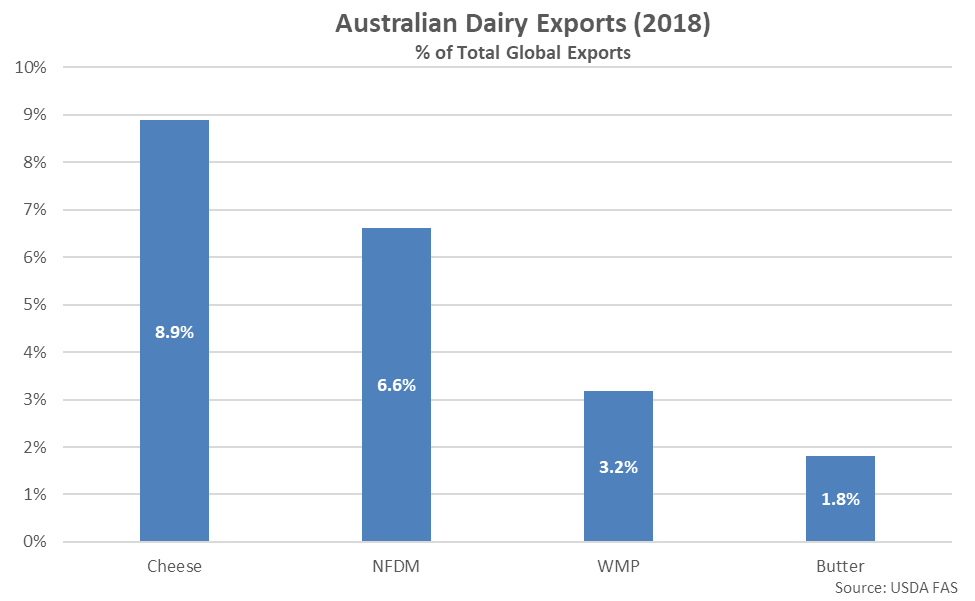
- Australian milk production declined on a YOY basis for the 16th consecutive month during Sep ’19, finishing down 4.5% to a 24 year seasonal low level. Hot and dry weather conditions experienced across Australia have contributed to the recently experienced declines in production volumes.
- Low farmgate milk prices and poor weather conditions contributed to the Australian dairy cow declining 3.2% to the lowest figure on record during 2017. The Australian dairy cow herd rebounded slightly throughout 2018 as rising farmgate milk prices supported herd rebuilding, however USDA expects the Australian dairy cow herd to decline 50,000 head, or 3.3%, throughout 2019, finishing at the lowest figure on record.
- Australia is the fourth largest global dairy exporter, accounting for 6.5% of combined butter, cheese, nonfat dry milk and whole milk powder exports throughout 2018. The bulk of Australian dairy exports are in the form of cheese and nonfat dry milk. A growing population, coupled with strong demand for milk and dairy products, is expected to result in lower Australian dairy exports over the next year if milk production volumes remain lower YOY. From a global perspective, cheese and nonfat dry milk markets may be most affected by a continued decline in Australian milk production.
 ’17-’18 annual Australian milk production increased 3.0% from the 20 year low experienced throughout the previous production season as improved rainfall led to better pasture growth however ’18-’19 annual production declined 5.7% as dry weather conditions returned, reaching a 24 year low level, overall. USDA has projected a 7.5% YOY decline in Australian milk production throughout the 2019 calendar year due to the likely continuation of unfavorable seasonal conditions in most dairy regions. Australian milk production volumes have declined 8.1% YOY throughout the first three quarters of the 2019 calendar year.
’17-’18 annual Australian milk production increased 3.0% from the 20 year low experienced throughout the previous production season as improved rainfall led to better pasture growth however ’18-’19 annual production declined 5.7% as dry weather conditions returned, reaching a 24 year low level, overall. USDA has projected a 7.5% YOY decline in Australian milk production throughout the 2019 calendar year due to the likely continuation of unfavorable seasonal conditions in most dairy regions. Australian milk production volumes have declined 8.1% YOY throughout the first three quarters of the 2019 calendar year.
 Recently experienced adverse conditions contributed to the Australian dairy cow herd contracting by 3.2% throughout 2017, to 1.51 million head, finishing at the lowest figure on record. The Australian dairy cow herd rebounded slightly throughout 2018 as rising farmgate milk prices supported herd rebuilding, however USDA expects the Australian dairy cow herd to decline 50,000 head, or 3.3%, throughout 2019, finishing at the lowest figure on record. Low pasture volumes and supplementary feed on hand are expected to contribute to the decline in cow numbers throughout the second half of 2019.
Recently experienced adverse conditions contributed to the Australian dairy cow herd contracting by 3.2% throughout 2017, to 1.51 million head, finishing at the lowest figure on record. The Australian dairy cow herd rebounded slightly throughout 2018 as rising farmgate milk prices supported herd rebuilding, however USDA expects the Australian dairy cow herd to decline 50,000 head, or 3.3%, throughout 2019, finishing at the lowest figure on record. Low pasture volumes and supplementary feed on hand are expected to contribute to the decline in cow numbers throughout the second half of 2019.
 Australia is the fourth largest global dairy exporter, trailing only New Zealand, the EU-28 and the U.S. Of the top five dairy exporting regions accounting for over 90% of total global dairy exports, Australia accounts for 3.1% of total combined milk production and 6.5% of combined butter, cheese, nonfat dry milk (NFDM) and whole milk powder (WMP) export volumes throughout 2018.
Australia is the fourth largest global dairy exporter, trailing only New Zealand, the EU-28 and the U.S. Of the top five dairy exporting regions accounting for over 90% of total global dairy exports, Australia accounts for 3.1% of total combined milk production and 6.5% of combined butter, cheese, nonfat dry milk (NFDM) and whole milk powder (WMP) export volumes throughout 2018.
 The bulk of Australian dairy exports are in the form of cheese and NFDM. Australia was the fourth largest exporter of both cheese and NFDM throughout 2018, accounting for 8.9% of global cheese export volumes and 6.6% of global NFDM export volumes. A growing population, coupled with strong demand for milk and dairy products, is expected to result in lower Australian dairy exports over the next year if milk production volumes remain lower YOY. From a global perspective, cheese and NFDM markets may be most affected by a continued decline in Australian milk production.
The bulk of Australian dairy exports are in the form of cheese and NFDM. Australia was the fourth largest exporter of both cheese and NFDM throughout 2018, accounting for 8.9% of global cheese export volumes and 6.6% of global NFDM export volumes. A growing population, coupled with strong demand for milk and dairy products, is expected to result in lower Australian dairy exports over the next year if milk production volumes remain lower YOY. From a global perspective, cheese and NFDM markets may be most affected by a continued decline in Australian milk production.
